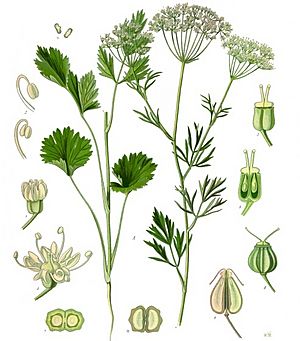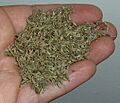Anise facts for kids
Quick facts for kids Anise |
|
|---|---|
 |
|
| Scientific classification | |
| Kingdom: | |
| Division: | |
| Class: | |
| Order: | |
| Family: | |
| Genus: |
Pimpinella
|
| Species: |
P. anisum
|
| Binomial name | |
| Pimpinella anisum |
|
Anise (Pimpinella anisum), also known as anís or aniseed, is a cool flowering plant that smells and tastes a bit like liquorice! It's part of the Apiaceae family, which also includes carrots and parsley. This plant originally comes from the eastern Mediterranean region and southwest Asia. People love to use anise for its unique flavor in many foods and drinks.
Anise was even used a long time ago, in the Middle Ages, to make a special spiced wine called claret.
Contents
What is Anise?
Anise is a small plant that usually grows to be about 60 to 90 centimeters (2 to 3 feet) tall. It has slender stems and feathery leaves. The plant produces small, white flowers that grow in umbrella-shaped clusters, which is typical for plants in the Apiaceae family.
The Special Seeds
The most important part of the anise plant is its small, oval-shaped fruits, which are often called "seeds." These seeds are what give anise its famous flavor. They are greenish-brown and have a slightly fuzzy texture. Inside these tiny seeds is a special oil that makes them taste and smell so unique.
Where Anise Grows
Anise is native to warm areas like the eastern Mediterranean, including countries such as Greece, Turkey, and Egypt. It also grows naturally in parts of southwest Asia. Today, farmers grow anise in many other places around the world, including India, China, and parts of Europe, because it's so popular. It needs sunny weather and well-drained soil to grow best.
What Anise Tastes Like
The flavor of anise is very distinct. Most people describe it as tasting like liquorice, which is a sweet and strong flavor. It also has hints of fennel and tarragon. This unique taste comes from a natural compound called anethole, which is found in the plant's essential oil. Anethole is what gives many licorice-flavored things their taste.
How People Use Anise
Anise has been used for thousands of years, not just for its flavor but also for its traditional health benefits.
Anise in Cooking
Anise seeds are a popular spice in many different cultures.
- Baking: You can find anise in breads, cakes, and cookies, especially in European and Middle Eastern sweets. It adds a warm, sweet, and slightly spicy flavor.
- Drinks: Anise is used to flavor many alcoholic drinks, like ouzo in Greece, raki in Turkey, and pastis in France. It's also used in some non-alcoholic teas and beverages.
- Savory Dishes: Sometimes, anise is used in savory dishes, like soups or stews, to add a unique twist. It's also a common ingredient in some spice blends.
Anise in Traditional Medicine
For a long time, people have used anise in traditional medicine.
- Digestion: It was often used to help with upset stomachs, gas, and other digestion problems.
- Coughs: Some people used anise to help soothe coughs and clear airways.
- Breath Freshener: Chewing anise seeds was a common way to freshen breath.
It's important to remember that while anise has been used traditionally, you should always talk to a doctor or healthcare professional before using any plant for medicinal purposes.
Images for kids
-
An unwrapped 'Troach drop', purchased at the Black Country Living Museum in the English Midlands, where such sweets are traditional
See also
 In Spanish: Pimpinella anisum para niños
In Spanish: Pimpinella anisum para niños








